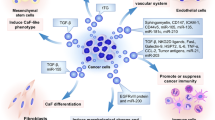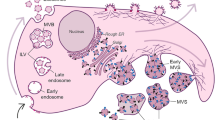Abstract
Extracellular vesicles (EVs) have emerged as an intercellular communication mediator in cancer. They seem to be involved in tumor processes by means of transformation of surrounding cells previous to metastasis by transferring miRNAs and oncogenic proteins. It is known that EVs, depending on their source, can be exosomes or ectosomes. Although the first type constitutes a specific population formed from the endosomal system, via multivesicular bodies, the ectosome biogenesis is not yet well known. In this study, we report a new type of EVs which has been termed spheresomes. While exosomes come from multivesicular bodies and ectosomes from direct budding of plasma membrane, spheresomes present a new mechanism of shedding from a spherical membrane structure which we have named multivesicular spheres. These EVs are first described in gastrointestinal stromal tumor cells in the present study. But moreover, these new membrane spherical structures appear not only next to tumoral cells but also different distances from them. Since some other authors have evidenced oncogenic KIT-containing EVs, it is also suggested here that surrounding cells uptake of these first described EVs, GIST-derived spheresomes, could induce tumor invasiveness. That is why the prevention of signaling processes developed by these new EVs may represent an alternative approach for GIST treatment.






Similar content being viewed by others
References
Akers JC, Gonda D, Kim R et al (2013) Biogenesis of extracellular vesicles (EV): exosomes, microvesicles, retrovirus-like vesicles, and apoptotic bodies. J Neurooncol 113:1–11
Albulescu R, Tanase C, Codrici E, Popescu DI, Cretoiu SM, Popescu LM (2015) The secretome of myocardial telocytes modulates the activity of cardiac stem cells. J Cell Mol Med 19(8):1783–1794
Atay S, Banskota S, Crow J et al (2014) Oncogenic KIT-containing exosomes increase gastrointestinal stromal tumor cell invasion. Proc Natl Acad Sci USA 111(2):711–716
Bobrie A, Colombo M, Raposo G, Théry C (2011) Exosome secretion: molecular mechanisms and roles in immune responses. Traffic 12(12):1659–1668
Booth AM, Fang Y, Fallon JK et al (2006) Exosomes and HIV Gag bud from endosome-like domains of the T cell plasma membrane. J Cell Biol 172(6):923–935
Bromisz Z, Wang Y, Nowicki MO et al (2014) Extracellular vesicles modulate the glioblastoma microenvironment via a tumor suppression signaling network directed by miR-1. Cancer Res 74(3):738–750
Burger D, Schock S, Thompson CS et al (2013) Microparticles: biomarkers and beyond. Clin Sci 124(7):423–441
Camussi G, Deregibus MC, Bruno S et al (2010) Exosomes/microvesicles as a mechanism of cell-to-cell communication. Kidney Int 78(9):838–848
Cantarero I, Luesma MJ, Junquera C (2011a) Identification of telocytes in the lamina propia of rat dudodenum: transmission electron microscopy. J Cell Mol Med 15:26–30
Cantarero I, Luesma MJ, Junquera C (2011b) The primary cilium of telocytes in the vasculature: electron microscope imaging. J Cell Mol Med 15(12):2594–2600
Castiella T, Muñoz G, Luesma MJ et al (2013) Primary cilia in gastric gastrointestinal stromal tumours (GISTs): an ultrastructural study. J Cell Mol Med 17(7):844–853
Choi DS, Choi DY, Hong BS et al (2012) Quantitative proteomics of extracellular vesicles derived from human primary and metastatic colorectal cancer cells. J Extracell Ves 1:18704
Choi DS, Kim DK, Kim YK, Gho YS (2013) Proteomics, transcriptomics and lipidomics of exosomes and ectosomes. Proteomics 13(10–11):1554–1571
Choi DS, Kim DK, Kim YK, Gho YS (2014) Proteomics of extracellular vesicles: exosomes and ectosomes. Mass Spectrom Rev 34(4):474–490
Cocucci E, Racchetti G, Meldolesi J (2009) Shedding microvesicles: artefacts no more. Trends Cell Biol 19:43–51
Cretoiu D, Gherghiceanu M, Hummel E, Zimmermann H, Simionescu O, Popescu LM (2015) FIB-SEM tomography of human skin telocytes and their extracellular vesicles. J Cell Mol Med 19(4):714–722
D’Souza-Schorey C, Clancy J (2012) Tumor-derived microvesicles: shedding light on novel microenvironment modulators and prospective cancer biomarkers. Genes Dev 26:1287–1299
Dolo V, Ginestra A, Cassara D et al (1998) Selective localization of matrix metalloproteinase 9, β1 integrins, and human lymphocyte antigen class I molecules on membrane vesicles shed by 8701-BC breast carcinoma cells. Cancer Res 58:4468–4474
Dolo V, D’Ascenzo S, Violini S et al (1999) Matrix-degrading proteinases are shed in membrane vesicles by ovarian cancer cells in vivo and in vitro. Clin Exp Metastas 17:131–140
Elmore S (2007) Apoptosis: a review of programmed cell death. Toxicol Pathol 35(4):495–516
Fertig ET, Gherghiceanu M, Popescu LM (2014) Extracellular vesicles release by cardiac telocytes electron microscopy and electron tomography. J Cell Mol Med 18(10):1937–1943
Février B, Raposo G (2004) Exosomes: endosomal-derived vesicles shipping extracellular messages. Curr Opin Cell Biol 16(4):415–421
Ge R, Tan E, Sharghi-Namini S, Asada HH (2012) Exosomes in cancer microenvironment and beyond: have we overlooked these extracellular messengers? Cancer Microenviron 5(3):323–332
Ginestra A, La Placa MD, Saladino F et al (1998) The amount and proteolytic content of vesicles shed by human cancer cell lines correlates with their in vitro invasiveness. Anticancer Res 18:3433–3437
Grange C, Tapparo M, Collino F et al (2011) Microvesicles released from human renal cancer stem cells stimulate angiogenesis and formation of lung pre-metastatic niche. Cancer Res 71:5346–5356
Graves LE, Ariztia EV, Navari JR et al (2004) Proinvasive properties of ovarian cancer ascites-derived membrane vesicles. Cancer Res 64:7045–7049
Gyorgy B, Szabo TG, Pasztoi M et al (2011) Membrane vesicles, current state-of-the-art: emerging role of extracellular vesicles. Cell Mol Life Sci 68:2667–2688
Hirota S, Isozaki K, Moriyama Y et al (1998) Gain-of-function mutations of C-KIT in human gastrointestinal stromal tumors. Science 279:577–580
Hood JL, San RS, Wickline SA (2011) Exosomes released by melanoma cells prepare sentinel lymph nodes for tumor metastasis. Cancer Res 71:3792–3801
Johnstone RM, Bianchini A, Teng K (1989) Reticulocyte maturation and exosome release: transferrin receptor containing exosomes shows multiple plasma membrane functions. Blood 74(5):1844–1851
Kaplan R, Riba R, Zacharoulis S et al (2005) VEGFR1-positive haematopoietic bone marrow progenitors initiate the premetastatic niche. Nature 438(7069):820–827
Kim DK, Kang B, Kim OY et al (2013) EVpedia: an integrated database of high-throughput data for systemic analyses of extracellular vesicles. J Extracell Vesicles 2:20384
Kindblom LG, Remotti HE, Aldenborg F, Meis-Kindblom JM (1998) Gastrointestinal pacemaker cell tumor (GIPACT): gastrointestinal stromal tumors show phenotypic characteristics of the interstitial cells of Cajal. Am J Pathol 152(5):1259–1269
Li J, Sherman-Baust CA, Tsai-Turton M et al (2009) Claudin-containing exosomes in the peripheral circulation of women with ovarian cancer. BMC Cancer 9:244–255
Losche W, Scholz T, Temmler U et al (2004) Platelet derived microvesicles transfer tissue factor to monocytes but not to neutrophils. Platelets 15:109–115
Martins VR, Diasa MS, Hainaut P (2013) Tumor-cell-derived microvesicles as carriers of molecular information in cancer. Curr Opin Oncol 25:66–75
Muralidharan-Chari V, Clancy J, Plou C, Romao M et al (2009) ARF6-regulated shedding of tumor cell-derived plasma membrane microvesicles. Curr Biol 19:1875–1885
Ostrowski M, Carmo NB, Krumeich S et al (2010) Rab27a and Rab27b control different steps of the exosome secretion pathway. Nat Cell Biol 12:19–30
Pan BT, Teng K, Wu C et al (1985) Electron microscopic evidence for externalization of the transferring receptor in vesicular form in sheep reticulocytes. J Cell Biol 101(3):942–948
Pap E, Pállinger É, Pásztói M, Falus A (2009) Highlights of a new type of intercellular communication: microvesicle-based information transfer. Inflamm Res 58(1):1–8
Peinado H, Alečković M, Lavotshkin S et al (2012) Melanoma exosomes educate bone marrow progenitor cells toward a pro-metastatic phenotype through MET. Nat Med 18(6):883–891
Pluskota E, Woody NM, Szpak D et al (2008) Expression, activation and function of integrin α-M-β2 (Mac-1) on neutrophil-derived microparticles. Blood 112:2327–2335
Raposo G, Stoorvogel W (2013) Extracellular vesicles: exosomes, microvesicles and friends. J Cell Biol 200(4):373–383
Ratajczak J, Wysoczynski M, Hayek F et al (2006) Membrane-derived microvesicles: important and underappreciated mediators of cell-to-cell communication. Leukemia 20(9):1487–1495
Somasundaram R, Herlyn M (2012) Melanoma exosomes: messengers of metastasis. Nat Med 18(6):853–854
Tan A, De La Pena H, Seifalian AM (2010) The application of exosomes as a nanoscale cancer vaccine. Int J Nanomed 5:889–900
Taylor DD, Gercel-Taylor C (2013) The origin, function, and diagnostic potential of RNA within extracellular vesicles present in human biological fluids. Front Genet 30(4):142
Théry C, Zitvogel L, Amigorena S (2002) Exosomes: composition, biogenesis and function. Nat Rev Immunol 2(8):569–579
Tominaga N, Kosaka N, Ono M et al (2015) Brain metastatic cancer cells release microRNA-181c-containing extracellular vesicles capable of destructing blood–brain barrier. Nat Commun 6:6716
Vader P, Breakefield XO, Wood JM (2014) Extracellular vesicles: emerging targets for cancer therapy. Trends Mol Med 20(7):385–393
Wang W, Li H, Zhoua Y, Jie S (2013) Peripheral blood microvesicles are potential biomarkers for hepatocellular carcinoma. Cancer Biomark 13(5):351–357
Acknowledgments
Authors would like to acknowledge the use of Research Support General Service—SAI, University of Zaragoza and Mario Soriano for his excellent technical support.
Financial support
Authors acknowledge the financial support of Diputación General de Aragón (DGA-B83) and University of Zaragoza (UZ 2013 - FIS - 04).
Author contributions
C.J. designed the research, performed microscopy assessment and contributed writing the paper; T.C. classified the samples by electron microscopy technique assessment; G.M. collected and histopathologically diagnosed the samples; R.F. set up and performed STEM-HAADF technique; M.J.L. contributed to microscopy assessment; and M.M. contributed writing the paper.
Author information
Authors and Affiliations
Corresponding author
Ethics declarations
Conflict of interest
All authors declare that they have no conflict of interest.
Rights and permissions
About this article
Cite this article
Junquera, C., Castiella, T., Muñoz, G. et al. Biogenesis of a new type of extracellular vesicles in gastrointestinal stromal tumors: ultrastructural profiles of spheresomes. Histochem Cell Biol 146, 557–567 (2016). https://doi.org/10.1007/s00418-016-1460-5
Accepted:
Published:
Issue Date:
DOI: https://doi.org/10.1007/s00418-016-1460-5




